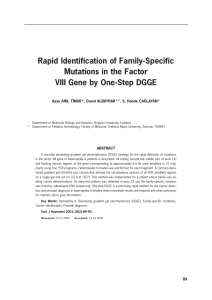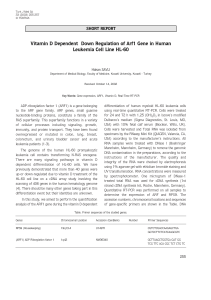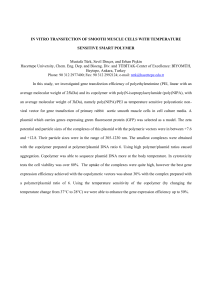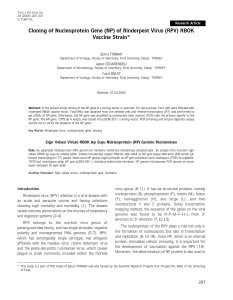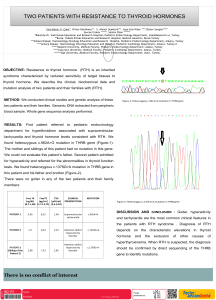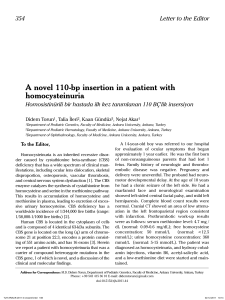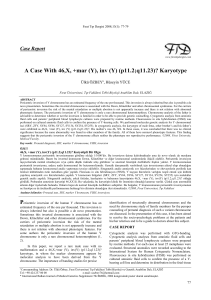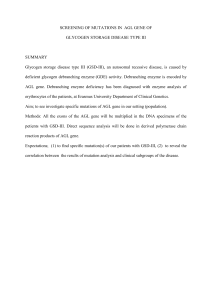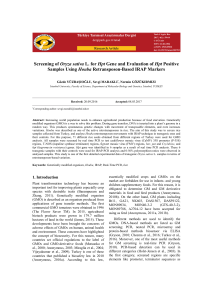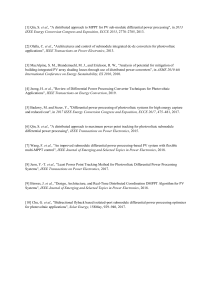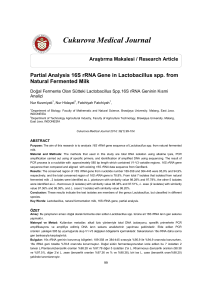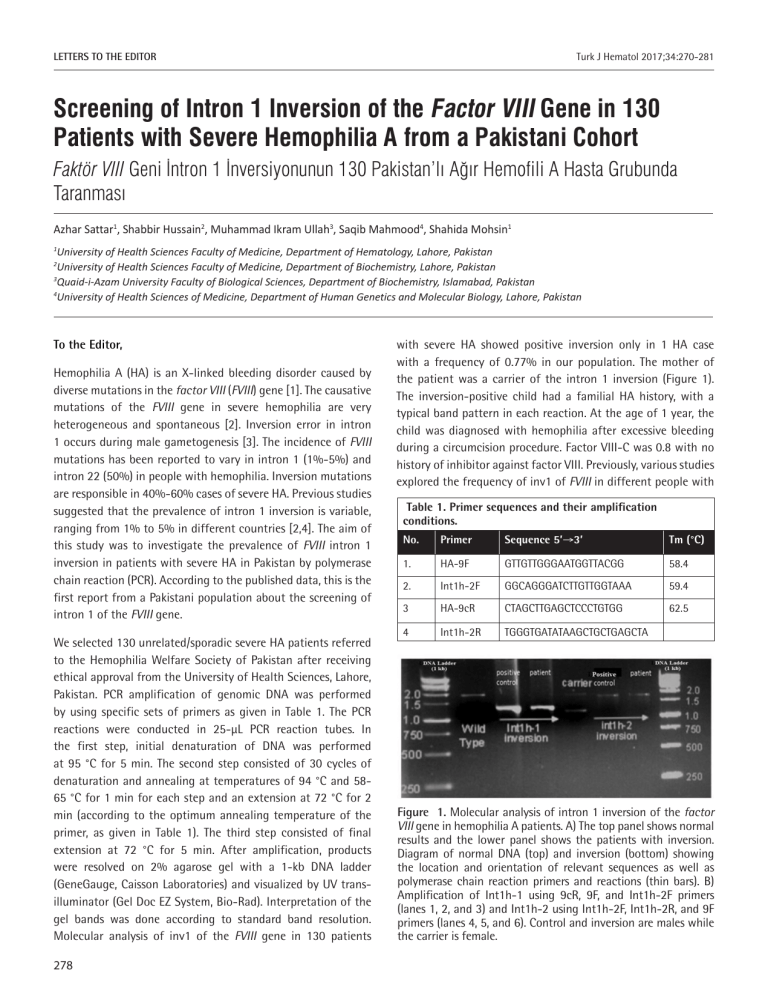
LETTERS TO THE EDITOR
Turk J Hematol 2017;34:270-281
Screening of Intron 1 Inversion of the Factor VIII Gene in 130
Patients with Severe Hemophilia A from a Pakistani Cohort
Faktör VIII Geni İntron 1 İnversiyonunun 130 Pakistan’lı Ağır Hemofili A Hasta Grubunda
Taranması
Azhar Sattar1, Shabbir Hussain2, Muhammad Ikram Ullah3, Saqib Mahmood4, Shahida Mohsin1
University of Health Sciences Faculty of Medicine, Department of Hematology, Lahore, Pakistan
University of Health Sciences Faculty of Medicine, Department of Biochemistry, Lahore, Pakistan
3
Quaid-i-Azam University Faculty of Biological Sciences, Department of Biochemistry, Islamabad, Pakistan
4
University of Health Sciences of Medicine, Department of Human Genetics and Molecular Biology, Lahore, Pakistan
1
2
To the Editor,
Hemophilia A (HA) is an X-linked bleeding disorder caused by
diverse mutations in the factor VIII (FVIII) gene [1]. The causative
mutations of the FVIII gene in severe hemophilia are very
heterogeneous and spontaneous [2]. Inversion error in intron
1 occurs during male gametogenesis [3]. The incidence of FVIII
mutations has been reported to vary in intron 1 (1%-5%) and
intron 22 (50%) in people with hemophilia. Inversion mutations
are responsible in 40%-60% cases of severe HA. Previous studies
suggested that the prevalence of intron 1 inversion is variable,
ranging from 1% to 5% in different countries [2,4]. The aim of
this study was to investigate the prevalence of FVIII intron 1
inversion in patients with severe HA in Pakistan by polymerase
chain reaction (PCR). According to the published data, this is the
first report from a Pakistani population about the screening of
intron 1 of the FVIII gene.
We selected 130 unrelated/sporadic severe HA patients referred
to the Hemophilia Welfare Society of Pakistan after receiving
ethical approval from the University of Health Sciences, Lahore,
Pakistan. PCR amplification of genomic DNA was performed
by using specific sets of primers as given in Table 1. The PCR
reactions were conducted in 25-µL PCR reaction tubes. In
the first step, initial denaturation of DNA was performed
at 95 °C for 5 min. The second step consisted of 30 cycles of
denaturation and annealing at temperatures of 94 °C and 5865 °C for 1 min for each step and an extension at 72 °C for 2
min (according to the optimum annealing temperature of the
primer, as given in Table 1). The third step consisted of final
extension at 72 °C for 5 min. After amplification, products
were resolved on 2% agarose gel with a 1-kb DNA ladder
(GeneGauge, Caisson Laboratories) and visualized by UV transilluminator (Gel Doc EZ System, Bio-Rad). Interpretation of the
gel bands was done according to standard band resolution.
Molecular analysis of inv1 of the FVIII gene in 130 patients
278
with severe HA showed positive inversion only in 1 HA case
with a frequency of 0.77% in our population. The mother of
the patient was a carrier of the intron 1 inversion (Figure 1).
The inversion-positive child had a familial HA history, with a
typical band pattern in each reaction. At the age of 1 year, the
child was diagnosed with hemophilia after excessive bleeding
during a circumcision procedure. Factor VIII-C was 0.8 with no
history of inhibitor against factor VIII. Previously, various studies
explored the frequency of inv1 of FVIII in different people with
Table 1. Primer sequences and their amplification
conditions.
No.
Primer
Sequence 5’→3’
Tm (°C)
1.
HA-9F
GTTGTTGGGAATGGTTACGG
58.4
2.
Int1h-2F
GGCAGGGATCTTGTTGGTAAA
59.4
3
HA-9cR
CTAGCTTGAGCTCCCTGTGG
62.5
4
Int1h-2R
TGGGTGATATAAGCTGCTGAGCTA
Figure 1. Molecular analysis of intron 1 inversion of the factor
VIII gene in hemophilia A patients. A) The top panel shows normal
results and the lower panel shows the patients with inversion.
Diagram of normal DNA (top) and inversion (bottom) showing
the location and orientation of relevant sequences as well as
polymerase chain reaction primers and reactions (thin bars). B)
Amplification of Int1h-1 using 9cR, 9F, and Int1h-2F primers
(lanes 1, 2, and 3) and Int1h-2 using Int1h-2F, Int1h-2R, and 9F
primers (lanes 4, 5, and 6). Control and inversion are males while
the carrier is female.
LETTERS TO THE EDITOR
Turk J Hematol 2017;34:270-281
hemophilia through PCR methods [1,5]. The frequency of inv1
reported in different populations is quite variable at 1.7% for
the Italian population [6], 5.1% in the Spanish population [7],
and about 8% in patients of Indian origin [2]. However, inv1
was not identified in 104 Hungarian patients with severe HA [8].
Intron 1 inversion is considered to be an important molecular
factor, alteration of which may result in severe HA. Our results
(0.77%) clearly indicated the variability between populations
and confirm that inv1 is much less frequent than inv22.
Keywords: Hemophilia A, FVIII gene, Intron 1, Polymerase chain
reaction, Pakistan
Anahtar Sözcükler: Hemofili A, FVIII geni, İntron 1, Polimeraz
zincirleme reaksiyonu, Pakistan
Conflict of Interest: The authors declare no conflicts of interest,
including specific financial interests, relationships, and/or
affiliations relevant to the subject matter or materials included.
Financial Disclosure: This research was assisted in part by the
University of Health Sciences, Lahore, Pakistan.
References
1. Guo Z, Yang L, Qin X, Liu X, Zhang Y. Spectrum of molecular defects in 216
Chinese families with hemophilia A. Clin Appl Thromb Hemost 2017. [Epub
ahead of print].
2. Pinto P, Ghosh K, Shetty S. F8 gene mutation profile in Indian hemophilia A
patients: identification of 23 novel mutations and factor VIII inhibitor risk
association. Mutat Res 2016;786:27-33.
3. Bowen DJ. Haemophilia A and haemophilia B: molecular insights. Mol
Pathol 2002;55:1-18.
4. Sanna V, Ceglia C, Tarsitano M, Lombardo B, Coppola A, Zarrilli F, Castaldo
G, Di Minno G. Aberrant F8 gene intron 1 inversion with concomitant
duplication and deletion in a severe hemophilia a patient from southern
Italy. J Thromb Haemost 2013;11:195-197.
5. Bagnall RD, Giannelli F, Green PM. Int22h-related inversions causing
hemophilia A: a novel insight into their origin and a new more discriminant
PCR test for their detection. J Thromb Haemost 2006;4:591-598.
6. Salviato R, Belvini D, Radossi P, Tagariello G. Factor VIII gene intron 1
inversion: lower than expected prevalence in Italian haemophiliac severe
patients. Haemophilia 2004;10:194-196.
7. Tizzano EF, Cornet M, Baiget M. Inversion of intron 1 of the factor VIII
gene for direct molecular diagnosis of hemophilia A. Haematologica
2003;88:118-120.
8. Andrikovics H, Klein I, Bors A, Nemes L, Marosi A, Váradi A, Tordai A. Analysis
of large structural changes of the factor VIII gene, involving intron 1 and
22, in severe hemophilia A. Haematologica 2003;88:778-784.
Address for Correspondence/Yazışma Adresi: Azhar SATTAR, M.D.,
University of Health Sciences Faculty of Medicine, Department of Hematology,
Lahore, Pakistan
E-mail: milaya500@gmail.com
Received/Geliş tarihi: January 30, 2017
Accepted/Kabul tarihi: March 14, 2017
DOI: 10.4274/tjh.2017.0031
©Copyright 2017 by Turkish Society of Hematology
Turkish Journal of Hematology, Published by Galenos Publishing House
279

